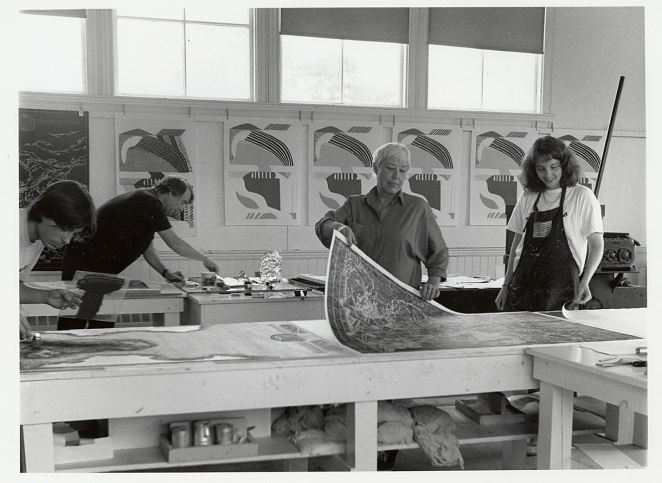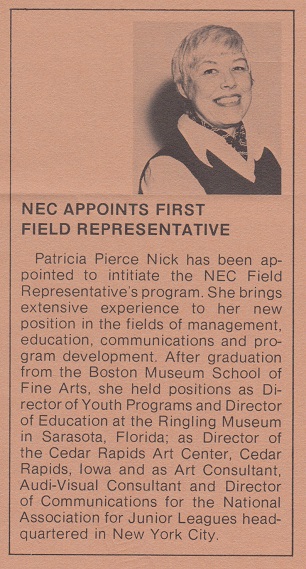
An Interview with Patricia Nick, NEMA's first Executive Director
By Dan Yaeger, Executive Director, NEMA
It was 1976, the year of the nation’s Bicentennial and a heady time for the museum field. Buoyed by a wave of patriotism and interest in heritage, museums were being created across New England and the country at the rate of one every three days. More museums meant more museum staff, which resulted in a demand for staff training. In this exciting, sometimes chaotic environment, Patricia Nick became the first paid staffer of the organization that was to become the New England Museum Association.
Although NEMA had roots dating back to 1918 (click here for more NEMA history), the organization by 1976 was beginning to outgrow its all-volunteer structure and was poised for a new chapter.
“When I arrived on the scene, it was a loose group of museum directors who got together to promote training for the museum field,” said Pat during a recent interview. Nearing 90 years old, she looks back fondly on her days with the organization.
“We were at the forefront of a movement that was forming at the time,” she said. “There was a lot of activity and membership growth. We were set up to help to provide training, mostly for entry-level staff people” at museums. “We were the first organization to do this at a regional level.”
Pat was hired initially as the “Field Representative” of what was then called the New England Conference, an offshoot of the American Association of Museums. Her role, funded by a grant from the National Museum Act administered by the Smithsonian Institution, was to create workshops, publications, and support for museum professionals throughout the region.
“It was a lot of fun back then,” she said. “There were many opportunities for people to feel connected. We produced top-notch workshops with really excellent speakers, a variety of membership wing-dings, and of course the annual conference, which was held at interesting places.”
Later in 1976, Pat was given the title of “Executive Director,” reflecting a growing professionalism in the organization which culminated with its formal incorporation as the New England Museum Association three years later. Housed at the DeCordova Museum in Lincoln, Massachusetts (where NEMA president Frederick Walkey was director), NEMA experienced a period of rapid growth, with membership expanding from less than 100 members to 170 institutional members and 600 individual members during her tenure from 1976 – 1982.
Pat was raised in Lexington, Massachusetts, and graduated from the School of the Museum of Fine Arts in Boston with a degree in printmaking. Prior to joining NEMA she held positions at the MFA/Boston, Ringling Museum in Sarasota, Florida, as director of the Cedar Rapids (IA) Art Center, and the National Association for Junior Leagues.
Her career after NEMA combined her love of art with her skills as an organizer. “I had spent summers on Vinalhaven Island [Maine] for my whole life,” she said, “So it was kind of natural that I would wind up here.” After her husband, architect Don Nick, died in 1984, Pat began restoring an abandoned, century-old schoolhouse on Vinalhaven with the idea of creating a workshop for artists to create high-quality prints for sale and exhibition.
Vinalhaven Press, which flourished until she retired in 2002, was a “summer camp” for artists such as Robert Indiana, Robert Morris, Yvonne Jacquette, Charles Hewitt, and Mel Chin. The limited-edition prints created there wound up in the collections of universities and museums such as the Portland Museum of Art and Smithsonian.
“We had a great time,” Pat said. Vinalhaven Press was more than a business, “it was a community.” Island resident Robert Indiana, with whom she remained friends until his death last year, “added glamour” to the enterprise, she said. “He liked to say he was the driving force behind the Press, but everyone knew I was the one who did all the work.”
Museums have changed greatly since her time at NEMA, Pat noticed. “They are much more professional, with better business practices. Even little house museums are much more sophisticated than they were. Museums have come a long way.”
And her advice for all the young professionals entering the field today? “Have fun,” she said. “Be creative. You have a wonderful opportunity to let your imagination run and help other people learn.”

Header photo: Pat Nick (center) at Vinalhaven Press